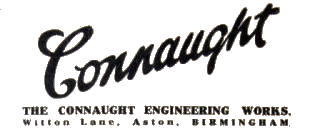

THE most striking feature of the 1915 Connaught programme is the introduction of a low-priced popular model, which is likely to have a large sale owing to the exceptional value offered. The bore and stroke remain as in previous and existing models (75x70 mm.), but the engine is altered in many details. The cylinder fins are arranged to give the cylinder a pear-shaped appearance, and the inlet port is formed in the side of the cylinder instead of directly below the exhaust port, as is the usual Connaught practice.
In addition to this, the transfer port leads from the crank case instead of through the piston. The crankshaft is fitted with phosphor bronze bearings, although ball bearings may be substituted at a slight extra charge. All models are now supplied with a cover to the release valve, which protects the rider from oily vapour.
The engine is mounted in a frame having a dropped top tube, and this, in combination with the 24in. wheels, gives a very low saddle position. Girder forks are used, for, though the machine is light, it is not skimped, and is intended for a serious touring machine as well as for a runabout. A two-speed countershaft gear may be fitted as an extra, in which case a combination drive is employed, and a large oil measure is carried in a convenient position on the saddle tube. The new model sells at 25 guineas, and should command a large market among such as require a handy and reliable mount obtainable at a moderate outlay and capable of hard work.
A Ladies' Model.
Other Connaught models remain much on the lines of their predecessors. Ball bearings are fitted to the crankshaft, and a few detail improvements have been carried out which make the machines even more attractive. An improved heel brake has been arranged on all models, and a striking open frame type is now marketed for ladies' use. This is thoroughly well fitted up. and is a mount particularly adapted for the fair sex, having a belt guard and footplates.
The Motor Cycle, December 17th, 1914. p681.
THE 1915 Connaught is very little changed in outward appearance, but many little improvements and refinements have been incorporated in the latest model. The front fork shackles and fixings have been much strengthened, and as regards the mudguards a reinforced strip is used which renders them much stronger than formerly.
The engine is practically the same as in 1914, viz., bore and stroke 75 x 70 mm. respectively. The piston has three rings, but the crankshaft is now mounted on Hoffmann ball bearings, and a shield is fitted over the release valve mechanism to prevent oil being splashed over the rider's overalls.
Though the Connaught is extremely low, and has a double top tube (of which not all lightweights boast), the tank capacity has not been unduly restricted.
The Connaught is obtainable either with a two-speed counter-shaft gear or a three-speed hub gear, whilst the single-geared model is sold at the modest figure of £33 10s.
The Motor Cycle, December 3rd, 1914. p617.
Bordesley Engineering Co., LTD., Birmingham.
If you have further information or a query related to this page, please contact us